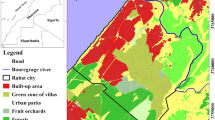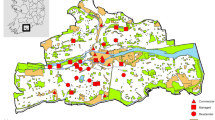Abstract
Human activities, through the development of agricultural and urbanized areas, are considered a threat to wildlife species. However, there are species that can be unaffected or even benefited by these man-made scenarios. This could be the case of the chimango caracara (Milvago chimango), a raptor species that may prove to be highly adapted to anthropogenic modifications of its habitat, requiring more detailed local population information to scientifically support that hypothesis. The aim of this study was to evaluate variation of density of chimango caracara in a urban gradient in central Argentina. During the Austral summer-autumn of 2017, I measured the abundance of chimango caracaras in 148 transects located in urban-suburban-rural urbanization gradients of 19 localities with human populations varying from 483 to 103,000 inhabitants per locality. Detection and density of chimango caracaras in each locality was analyzed as function of urban gradient, climate and number of inhabitants in each locality using a Distance Sampling approach. Urbanization and climate affected both detection and density. The selected model predicted the highest densities of chimango caracara in suburban, then in urban, and finally in rural habitats (0.18, 0.15 and 0.01 ind/ha respectively). These findings could be the result of the successful process of adaptation of chimango caracara to life in urbanized habitats and indicates that on certain occasions the anthropic disturbance could not be negative in terms of abundance for some species of birds with flexible behaviors.


Similar content being viewed by others
Availability of data and material
Data are available on request.
References
Andersen D (2007) Survey techniques. In: Bird D, Bildstein K (eds) Raptor research and management techniques. Hancock House Publisher, Washington, USA
Bellocq M, Filloy J, Garaffa P (2008) Influence of agricultural intensity and urbanization on the abundance of theraptor chimango caracara (Milvago chimango) in the Pampean region of Argentina. Ann Zool Fennici. 45:128–134
Biondi L, Bó M, Favero M (2005) Dieta del chimango (Milvago chimango) durante el periodo reproductivo en el sudeste de la provincia de Buenos Aires, Argentina. Ornitol Neotrop 16:31–42
Biondi L, Bó M, Vassallo A (2010) Inter-individual and age differences in exploration, neophobia and problem-solving ability in a Neotropical raptor (Milvago chimango). Anim Cogn 13:701–710. https://doi.org/10.1007/s10071-010-0319-8
Buckland S, Anderson D, Burnham K et al (2001) Introduction to distance sampling: Estimating abundance of biological populations. Oxford University Press, Oxford, U.K.
Buckland S, Anderson D, Burnham K et al (2004) Advanced distance sampling: Estimating abundance of biological populations. Oxford University Press, Oxford, U.K.
Burnham KP, Anderson DR (2002) Model selection and multimodel inference. a practical information-theoretic approach (2nd ed). Springer-Verlag, New York, USA
Cardador L, Carrete M, Mañosa S (2011) Can intensive agricultural landscapes favour some raptor species? The Marsh Harrier in north-eastern Spain. Anim Conserv 14:382–390. https://doi.org/10.1111/j.1469-1795.2011.00449.x
Carrete M, Tella J, Blanco G, Bertellotti M (2009) Effects of habitat degradation on the abundance, richness and diversity of raptors across Neotropical biomes. Biol Conserv 142:2002–2011. https://doi.org/10.1016/j.biocon.2009.02.012
Filloy J, Bellocq M (2007) Patterns of bird abundance along the agricultural gradient of the Pampean region. Agric Ecosyst Environ 120:291–298. https://doi.org/10.1016/j.agee.2006.09.013
Fiske IJ, Chandler RB (2011) Unmarked: An R package for fitting hierarchical models of wildlife occurrence and abundance. J Stat Softw 43:1–23. https://doi.org/10.18637/jss.v043.i10
Garaffa P, Filloy J, Bellocq M (2009) Bird community responses along urban-rural gradients: Does the size of the urbanized area matter? Landsc Urban Plan 90:33–41. https://doi.org/10.1016/j.landurbplan.2008.10.004
Hawkshaw KA, Nielsen ÓK, Franke A (2017) Monitoring prey populations with distance sampling surveys. In: Anderson D, Mcclure CJW, Franke A (eds) Applied Raptor Ecology: Essentials from Gyrfalcon Research. The Peregrine Fund, Boise, Idaho, USA, pp 147–170
Jaksić FM, Pavez EF, Jiménez JE, Torres-Mura JC (2001) The conservation status of raptors in the Metropolitan Region, Chile. J Raptor Res 35:151–158
Leveau LM, Gorleri FC, Roesler I, González-Táboas F (2022) What makes an urban raptor? Ibis (Lond 1859) 164:1213–1226. https://doi.org/10.1111/ibi.13062
Leveau LM, Isla FI, Bellocq MI (2015) Urbanization and the temporal homogenization of bird communities: a case study in central Argentina. Urban Ecosyst. https://doi.org/10.1007/s11252-015-0469-1
McKinney M (2002) Urbanization, biodiversity, and conservation. Bioscience 52:883–890
Miller DL, Rexstad E, Thomas L, et al (2017) Distance sampling in R. bioRxiv 63891. https://doi.org/10.1101/063891
Morrison J, Phillips L (2000) Nesting habitat and success of the Chimango Caracara in southern Chile. Wilson Bull 112:225–232
Muñoz-Pedreros A, Dellacasa V (2023) Diversity of diurnal raptors in a suburban area of a city in southern Chile. Urban Ecosyst. https://doi.org/10.1007/s11252-023-01330-2
Newson SE, Evans KL, Noble DG et al (2008) Use of distance sampling to improve estimates of national population sizes for common and widespread breeding birds in the UK. J Appl Ecol 45:1330–1338. https://doi.org/10.1111/j.1365-2664.2008.01480.x
Pedrana J, Isacch J, Bó M (2008) Habitat relationships of diurnal raptors at local and landscape scales in southern temperate grasslands of Argentina. Emu. 108:301–310
Pimm SL, Raven P (2000) Extinction by numbers. Nature 403:843–845
R Core Team (2019) R: A language and environment for statistical computing, Vienna, Austria
Rodríguez-Estrella R, Donázar JA, Hiraldo F (1998) Raptors as indicators of environmental change in the scrub habitat of Baja California Sur, Mexico. Conserv Biol 12:921–925. https://doi.org/10.1046/j.1523-1739.1998.97044.x
Royle JA, Dawson DK, Bates S (2004) Modeling abundance effects in distance sampling. Ecology 85:1591–1597
Sergio F, Caro T, Brown D (2008) Top predators as conservation tools: ecological rationale, assumptions, and efficacy. Annu Rev Ecol Syst 39:1–19
Sih A, Ferrari M, Harris D (2011) Evolution and behavioural responses to human-induced rapid environmental change. Evol Appl 4:367–387. https://doi.org/10.1111/j.1752-4571.2010.00166.x
Sillett TS, Chandler RB, Royle JA et al (2012) Hierarchical distance-sampling models to estimate population size and habitat-specific abundance of an island endemic. Ecol Appl 22:1997–2006. https://doi.org/10.1890/11-1400.1
Solaro C (2018) Costs and benefits of urban living in raptors. In: Sarasola J, Grande J, Negro J (eds) Birds of Prey Biology and conservation in the XXI century. Springer International Publishing AG part, Cham, Switzerland, pp 177–196
Solaro C, Sarasola JH (2019) Urban living predicts behavioural response in a neotropical raptor. Behav Process 169:103995. https://doi.org/10.1016/j.beproc.2019.103995
Solaro C, Sarasola JH (2015) Nest-spacing, not human presence, influences the breeding of Chimango Caracaras (Milvago chimango) in a peri-urban reserve. Emu 115:72–75. https://doi.org/10.1071/MU14038
Solaro C, Sarasola JH (2017) Natal dispersal and philopatry of Chimango Caracaras (Milvago chimango) in suburban, rural and natural habitats, determined by band recovery and re-sighting data. Emu 118:158–165
Sollmann R, Gardner B, Chandler RB et al (2015) An open-population hierarchical distance sampling model. Ecology 96:325–331. https://doi.org/10.1890/14-1625.1
Travaini A, Rodríguez A, Ceballos O, Donázar J, Hiraldo F (1995) Roadside raptor surveys in Central Argentina. Hornero. 014:64–66.
White C, Olsen P, Kiff L (1994) Order Falconiformes – Family Falconidae (Falcons and Caracaras). In: del Hoyo J, Elliot A, Sargatal J (eds) Handbook of the Birds of the World, vol 2. New World Vultures to Guineafowl. Lynx, Barcelona, pp 216–277
Acknowledgements
I am very grateful to Mariano Perez and Jaime Bernardos for their help in the census and in the data analysis respectively. I appreciate the improvements in English usage made by Phil Whitford through the Association of Field Ornithologists' program of editorial assistance. Funding for this study was provided by Facultad de Ciencias Exactas y Naturales, (UNLPam, PI N°32) and Agencia Nacional de Promoción Científica y Tecnológica (MinCyT, PICT2018-03579).
Funding
Funding for this study was provided by Facultad de Ciencias Exactas y Naturales, (UNLPam, PI N°32) and Agencia Nacional de Promoción Científica y Tecnológica (MinCyT, PICT2018-03579).
Author information
Authors and Affiliations
Contributions
Author contributions Conceptualization: Claudina Solaro; Methodology: Claudina Solaro; Formal analysis and investigation: Claudina Solaro; Writing—original draft preparation: Claudina Solaro; Review: Claudina Solaro.
Corresponding author
Ethics declarations
Ethics approval
Not applicable.
Competing interests
The authors declare no competing interests.
Rights and permissions
Springer Nature or its licensor (e.g. a society or other partner) holds exclusive rights to this article under a publishing agreement with the author(s) or other rightsholder(s); author self-archiving of the accepted manuscript version of this article is solely governed by the terms of such publishing agreement and applicable law.
About this article
Cite this article
Solaro, C. Numeric response of a neotropical raptor to urbanization gradient in central Argentina. Urban Ecosyst 27, 681–687 (2024). https://doi.org/10.1007/s11252-023-01484-z
Accepted:
Published:
Issue Date:
DOI: https://doi.org/10.1007/s11252-023-01484-z




